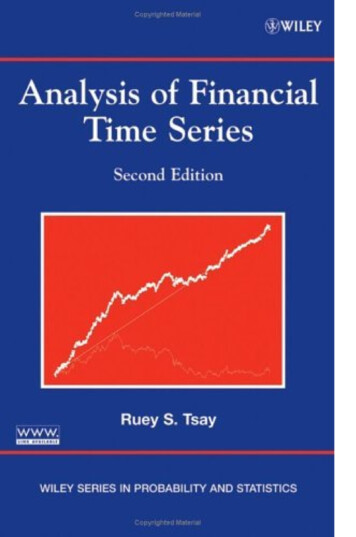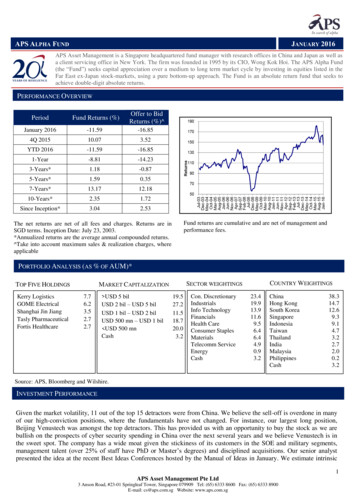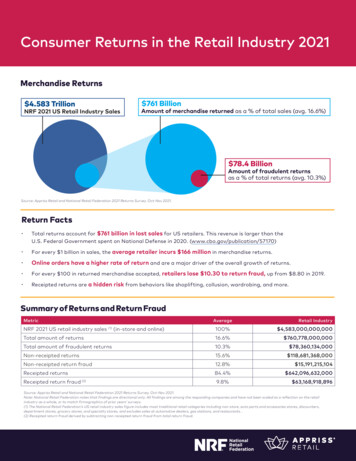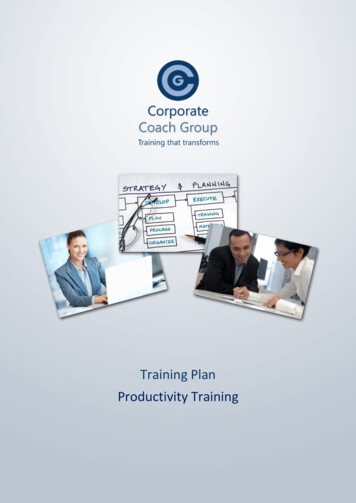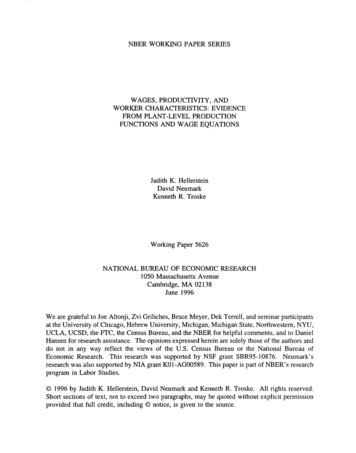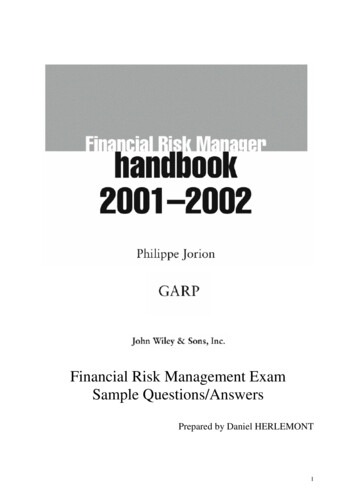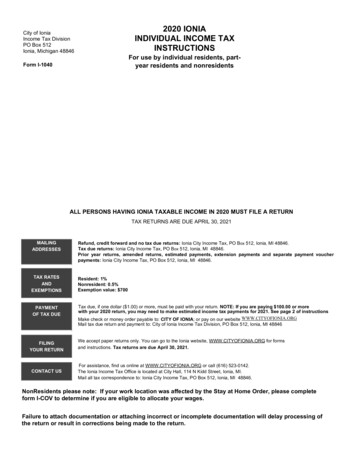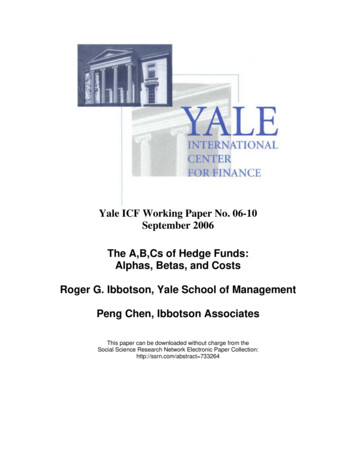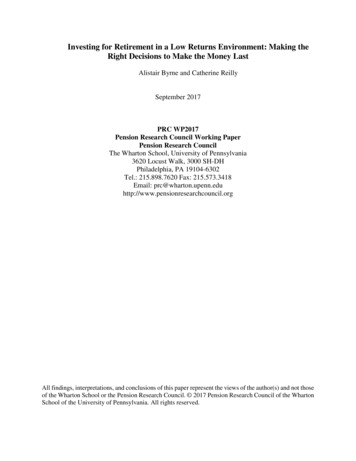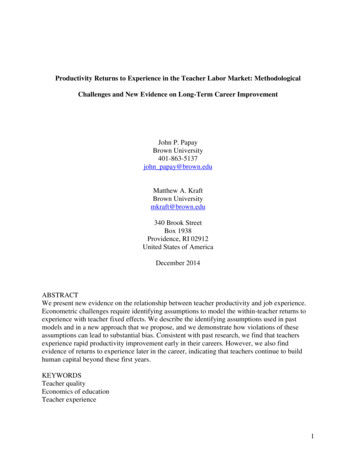
Transcription
Productivity Returns to Experience in the Teacher Labor Market: MethodologicalChallenges and New Evidence on Long-Term Career ImprovementJohn P. PapayBrown University401-863-5137john papay@brown.eduMatthew A. KraftBrown Universitymkraft@brown.edu340 Brook StreetBox 1938Providence, RI 02912United States of AmericaDecember 2014ABSTRACTWe present new evidence on the relationship between teacher productivity and job experience.Econometric challenges require identifying assumptions to model the within-teacher returns toexperience with teacher fixed effects. We describe the identifying assumptions used in pastmodels and in a new approach that we propose, and we demonstrate how violations of theseassumptions can lead to substantial bias. Consistent with past research, we find that teachersexperience rapid productivity improvement early in their careers. However, we also findevidence of returns to experience later in the career, indicating that teachers continue to buildhuman capital beyond these first years.KEYWORDSTeacher qualityEconomics of educationTeacher experience1
1. IntroductionOver the past decade, efforts to improve the elementary and secondary education systemin the United States have focused on ensuring that all students have an effective teacher in theirclassroom. The debates over how to accomplish this goal have been increasingly informed byteacher effectiveness research that has blossomed in recent years with the availability of largescale datasets that link teachers to students and test scores. These data have allowed researchersto examine central questions about the teacher labor market, including productivity dynamics– inother words, how do teachers improve their effectiveness over the course of their careers?The extent to which teacher performance in the classroom changes with experience hasboth theoretical and practical implications. Better understanding this dynamic will shed light onthe relationship between employee productivity and job experience, and also inform currenteducation policy initiatives such as teacher pay, evaluation, retention, and tenure. Many analysesof the relationship between teacher experience and productivity have relied on cross-sectionaldata, comparing the effectiveness of teachers at different experience levels. However, thiscomparison does not provide a clear picture of how teachers improve over the course of theircareers, largely because it ignores the issue of attrition. Even if teachers do improve withexperience, we can find flat returns to experience in the cross-section if the most effectiveteachers leave. Thus, the extent of within-teacher returns to experience provides more relevantguidance to policymakers about teacher improvement throughout the career.For much of the past decade, this question has been treated as settled (Rice, 2013; TNTP,2012). Policymakers and researchers tend to believe that teachers improve rapidly during theirinitial years in the classroom, but that the returns to experience flatten out after the first few yearsof teaching. These results have become quite influential in the policy community. However, two2
recent papers in this journal find otherwise, providing evidence that teachers continue to improveover the course of their careers (Harris & Sass, 2011; Wiswall, 2013).1In the first half of our paper, we reconcile these divergent results by laying out explicitlythe identifying assumptions that researchers have used in estimating the within-teacher returns toexperience (with teacher fixed effects), given the collinearity between experience and year fornearly all teachers. We demonstrate analytically and through simulation how violations of eachassumption can bias estimates, sometimes substantially. We also propose a new approach thatrelies on a substantively different assumption and, thus, is subject to a different source of bias. Inthe second half, we use data from a large urban school district to present estimates of the withinteacher returns to experience from these different models. Examining estimates from models thatrely on distinct identifying assumptions provides a clearer picture of the biases in each approachand enables us to present stronger evidence about the extent of later-career returns to experience.Like past researchers, and consistent with theory, we find that teachers in the districtimprove most rapidly at the beginning of their careers. However, across models, we find thatteachers continue to improve, albeit at lesser rates, past their first five years in the classroom. Wealso find suggestive evidence of continued returns to experience throughout the career,particularly in mathematics. These results make sense, as labor economists have long observedthat employee wages continue to rise with job experience. Human capital theory supports thispattern, holding that workers build skills that translate to greater productivity (Becker, 1993).Taken together, our results suggest that the question of whether teachers continue to improvewith experience is at least not settled and that policymakers should temper their policies toacknowledge this reality.1Given that “tenure” and “seniority” have specific meanings in the field of education, we use the term “experience”to reflect the number of years a teacher has been in the profession.3
In the next section, we describe past efforts to estimate the productivity returns toteaching experience. In section 3, we describe our dataset and measures. We then articulate thekey assumptions that underlie existing approaches, propose an alternative method, and discussthe bias introduced by each approach. In section 5, we present the estimated returns to teacherexperience from each of these approaches in our data. We describe several threats to the validityof our inferences and our attempts to address them in Section 6. Finally, we conclude with adiscussion of the economic and educational implications of this work.2. Estimates of the Returns to Experience in TeachingThe education sector is among the few industries for which direct estimates of workerproductivity are available for much of the labor force. In recent years, education economists haveproduced a growing body of literature that examines the productivity returns to job experienceamong teachers, using estimated contributions to student test score gains as a proxy forproductivity (see Todd & Wolpin, 2003, McCaffrey at al., 2004, and Harris & Sass, 2006). Wefocus on all aspects of productivity improvement that accrue to teachers over their careers – inother words, we seek to estimate the overall effect of experience on productivity, rather thandisentangling the reasons for these returns.2 Thus, we include as “returns to experience” theeffects of formal on-the-job training, informal on-the-job learning, out-of-work training (such asformal education) and any other factors that improve teacher effectiveness over time.Most research suggests that teachers improve a great deal at the beginning of their careers(e.g., Rockoff, 2004). Fast early-career improvement in productivity is not surprising, given that2There are both substantive and practical reasons for this. Substantively, we are interested in understanding howteachers improve over the course of their careers on average. Different teachers may take different paths to suchimprovement. Practically, many of these elements are notoriously difficult to measure. For example, in-schoolprofessional development can take many forms, only some of which are recorded. Formal education can be capturedin aggregate, such as whether teachers earn a masters’ degree, but we cannot distinguish finer-grained course-taking.As such, we focus on the broader question of whether teachers improve their productivity throughout their career.Finally, we find nearly identical returns to experience when we condition on teachers’ formal education.4
theory implies more rapid human capital development and greater investment earlier in thecareer (Becker, 1993). This pattern mirrors theories of the teacher career arc, where noviceteachers are often characterized as simply trying to survive in the classroom as they build keyclassroom management skills, learn the curriculum, and add to their instructional abilities(Johnson et al., 2004). Many factors contribute to the extent of early-career productivity growth,including the availability of effective colleagues (Jackson & Bruegmann, 2009), consistency inteaching assignments (Ost, 2014), and supportive work environments (Kraft & Papay, 2014).However, there is less agreement about the nature of returns to experience after theseearly years. On one hand, shirking models suggest that teachers, who face minimal oversight andenjoy strong job protections, may stop improving once they become established in their schools(Hansen, 2009). On the other, some theories of teacher career development suggest that, beyondtheir first few years, teachers may continue to refine their practice and gain the relationships andtime to collaborate with colleagues about instruction (Huberman, 1992). Recent evidencesuggests that veteran teachers can improve their instructional effectiveness if they participate in arigorous teacher evaluation program (Taylor & Tyler, 2012), find more productive schoolmatches (Jackson, 2013), or engage in effective on-the-job training (e.g., Matsumura et al., 2010;Neuman & Cunningham, 2009; Powell et al., 2010; Allen et al., 2011).As Murnane and Phillips (1981) made clear, cross-sectional estimates cannot fullydistinguish between true individual returns to job experience and vintage effects (i.e., averagedifferences in quality across teacher cohorts) or selection effects (i.e., differential attrition). Wefocus on this question by estimating the within-teacher returns to experience using longitudinaldata with teacher fixed effects. This line of work builds on Rockoff’s (2004) analysis of datafrom two school districts in New Jersey. Rockoff finds substantial early-career returns to5
teaching experience, particularly on reading test scores, but the returns to experience on all butreading comprehension scores diminish rapidly after the first few years in the classroom. Morerecently, Boyd and his colleagues (2008) have applied Rockoff’s general approach to examinedata in New York City and North Carolina, respectively, finding qualitatively similar results.These cross-sectional and longitudinal findings have been widely interpreted as evidencethat teachers do not improve their performance beyond their first few years in the classroom(Rivkin, Hanushek, & Kain, 2005). This interpretation has had a profound effect on educationpolicy. For example, Bill Gates (2009) asserted that “once somebody has taught for three years,their teaching quality does not change thereafter.” However, recent evidence suggests thatteachers may improve throughout their careers. Using data from Florida, Harris and Sass (2011)find that while the largest gains in experience accrue in the first few years, there are “continuinggains beyond the first five years of a teacher's career” (p. 1). Using data on 5th grade teachers inNorth Carolina, Wiswall finds that “teaching experience has a substantial and statisticallysignificant impact on mathematics achievement, even beyond the first few years of teaching”(2013, p. 62), although he finds no such returns in reading. We seek to resolve this divergentevidence by examining these approaches in more detail.3. Dataset and Measures3.1 DatasetIn order to examine within-teacher returns to experience, we use a comprehensiveadministrative dataset from a large, urban school district in the southern United States thatincludes student, teacher, and test records from the 2000-01 to the 2008-09 school years. Thisdistrict has over 100,000 students and nearly 9,000 teachers. Student data include demographicinformation, teacher-student links, and annual state test results in reading and mathematics. We6
standardize these test scores to interpret our estimates as standard deviation differences instudent performance.3 Because appropriate estimation of the education production functionrequires both baseline and outcome test data, we focus on teachers in grades four through eight.We exclude any students in atypically small classes or substantially separate special educationclasses.4 Our final dataset includes more than 200,000 student-year records, representing morethan 3,500 unique teachers over the 9-year panel. These students are fairly typical for an urbanschool district: 43% are African-American, 38% are White, and 12% are Hispanic, 10% areEnglish language learners, and 10% are enrolled in special educational services.Our key predictor of interest is the amount of time a teacher has spent teaching. We relyon experience as defined on the teacher salary scale. As in most U.S. public schools, teachers arepaid almost exclusively based on a combination of their years of experience and their educationalattainment. Although a teacher’s salary experience level is a fairly reliable indicator of actual onthe-job experience, it is not perfect. We indeed see some teachers – about 5% of our sample –whose salary experience jumps more than one year in a single year.5 As a result, we omitteachers with non-standard experience patterns from most of our models, although we investigatewhat happens when we include these teachers.The teachers in this district are fairly representative of those in urban school districts3Note that this standardization does not make the scales comparable from year to year because of differences intested material and changes in the distribution of student ability from year-to-year. However, the test measure weuse does not have a vertical scale that enables inferences about student growth from year-to-year.4Specifically, we exclude any teacher-year in which fewer than five students had value-added estimates. Weexclude any class with more than 90% of students in special education or more than 25% of students missingprevious year test scores. Doing so eliminates 7% of the sample. In Appendix Table A-3a and A-3b, we explore thesensitivity of our results to these restrictions, further limiting our sample to either (a) teacher-years in which fewerthan 10 students had value-added estimates or (b) teachers for whom 40 students had value-added estimates.5This can result from delays in the human resources office providing appropriate credit to teachers for past teachingexperience or from simple data errors. In a sensitivity analysis, we examined the consequences of this possiblemeasurement error by focusing on teachers whom we are confident enter the district as novices. We find that theestimated within-teacher returns to experience for these teachers are in fact greater than for the overall population,suggesting that measurement error may indeed be inducing a downward bias in our results. Results are availablefrom the authors on request.7
across the country – the large majority of teachers are white women. Most have limitedclassroom experience, and the number of veteran teachers is relatively small. For example, only19% of the district’s teaching staff has more than 20 years of experience. In Figure 1, we presentthe distribution of student-year observations in our mathematics sample, showing that there aremany more observations – and thus much greater precision – for teachers early in the career.64. Bias in Estimating the Returns to ExperienceThere are two key challenges facing researchers who seek to estimate the within-teacherreturns to experience. The first involves the widely-discussed difficulties in using studentachievement data to estimate teacher productivity. There are important limitations and trade-offsin specifying education production function models to estimate teacher effectiveness. We discussthese issues briefly in section 4.3 below. The second challenge involves how to specify modelsto estimate the within-teacher returns to experience. For teachers with standard career patterns,year and experience are collinear. This is an example of the classic age-period-cohort problem.4.1 Returns to Experience and the Age-Period-Cohort ProblemThe collinearity between year and experience within-teacher requires researchers to makeidentifying assumptions to separately estimate year-to-year productivity trends and returns toexperience in models that include teacher fixed effects (Deaton, 1997; Rockoff, 2004). To shedlight on a central piece of this challenge, we can imagine a simple data-generating process thatdetermines the productivity of teacher j in year t:(1) jt j * f (YEARt ) * f ( EXPER jt ) jtHere, a teacher’s effectiveness in a given year represents the sum of her initial productivity ( j ),any productivity shocks common across teachers in a given year ( * f (YEAR t ) ), the6We omit the very few teachers who ever had more than 40 years of experience. Because our sample of teacherswith more than 30 years of experience is so small, we present all figures up to a maximum of 30 years.8
incremental productivity teachers gain over the course of their career ( * f ( EXPER jt ) ), and anidiosyncratic mean-zero error term ( jt ). Note that all approaches implicitly assume that thereare no interactions between experience and year – in other words, we explicitly define the yeareffects as average shocks common to all teachers.We seek to fit models that will provide unbiased estimates of . However, directlyestimating a model based on equation (1) is challenging because, within teacher, experience andyear are collinear, at least for teachers with standard career trajectories. Thus, all researchersseeking to estimate must make an identifying assumption. The existing research has usedthree such models; we propose a fourth. Here, we lay out these four approaches, discuss their keyidentifying assumptions, and describe the potential bias associated with each. In short, the keydistinctions across these approaches are (a) whether they make assumptions about the returns toexperience profile itself and (b) what sample they use to identify key parameters.In theory, one possibility would simply be to omit the year effects, implicitly assumingthat they are random shocks by absorbing them into the error term. Rockoff (2004) recognizedthe serious limitations of this approach, given that many aspects of schools change over time. Forexample, if a district implements a policy that boosts student achievement (e.g., smaller classsizes) across all teachers in the district, within-teacher returns to experience would appear to beinflated. Rockoff (2004) developed a creative alternative. Relying on the literature, he saw theopportunity to identify year effects off of teachers with more than 10 years of experience becausesuch teachers did not appear to become substantially more effective in cross-sectional models(Rivkin, Hanushek, & Kain, 2005). This Censored Growth Model explicitly assumes that thereare no returns to experience after 10 years. Thus, this model requires an assumption about thefunctional form of the productivity-experience profile itself and restricts our inferences about9
teachers’ returns to experience to only the first 10 years of the career.7Rockoff’s (2004) innovation enables researchers to model both year effects and thereturns to experience jointly, in what we call the Censored Growth Model:(2) jt * f (YEAR t ) * f ( EXPER CGM) *1{EXPER jt 10} j jtjtHere EXPER CGM { EXPER jt if EXPER jt 10; 10 otherwise}, and we include an indicator thatjtexperience is greater than 10. We can conceptualize this model as a two-stage approach, firstestimating the year effects on the sample of teachers with more than 10 years of experience andthen applying these estimated year effects to a second stage equation. Because the modelexplicitly assumes the coefficient on the returns to experience for teachers above 10 years ofexperience to be zero, it essentially omits the experience effect in this first stage. Thisassumption produces potentially biased estimates of the year effect, as any returns to experienceafter year 10 will be conflated with the year effects. Thus, the mis-estimation of the year effectsproduces a bias in the estimated returns to experience for early-career teachers proportional tothese later-career returns to experience. If the assumption holds and teachers do not continue toimprove after 10 years in the classroom, this bias is zero. However, to the extent that there areany positive returns to experience after year 10, this model understates the true returns toexperience. Note that, by the same logic, any negative returns to experience after year 10 wouldoverstate the true returns to experience.A related approach is to specify experience as a set of indicator variables that representranges of experience; year effects can be identified off of teachers who fall within those ranges.For example, Harris & Sass (2011) replace f(EXPERjt) in equation (1) with dummy variablesrepresenting ranges from 1-2, 3-4, 5-9, 10-14, 15-24, and more than 25 years of experience. One7In practice, one can impose different experience cutoffs (e.g. Boyd et al., 2008) but, this model must include arange over which one cannot estimate the returns to experience.10
advantage of this Indicator Variable Model is that it enables researchers to estimate theproductivity-experience profile throughout the teaching career. In practice, by using within-binvariation to estimate the year effects, the Indicator Variable Model relies on a similar functionalform assumption. In this case, it assumes that teacher productivity does not change meaningfullywithin each of these experience bins.Thus, the source of bias in the Indicator Variable Model is analogous to that in theCensored Growth Model. Year effects are estimated off of teachers in certain experience bins,but, unlike the Censored Growth Model, these bins occur throughout the career. Any careergrowth in those bins will be conflated with year effects, leading to a downward bias in theestimated returns to experience; similarly, any within-teacher declines in productivity will lead toupward bias. Here, the bias is essentially a weighted average of the within-bin returns toexperience across all of the bins used in the model. The extent of bias thus depends on the natureof the bins; it is more severe if the bins include segments of the career when teachers arechanging their productivity substantially. For example, if these bins include ranges early in ateacher’s career, when productivity is increasing rapidly, we expect this model to introduce asubstantial downward bias.Both of these models make important contributions by estimating the within-teacherreturns to experience while simultaneously accounting for year effects, but they explicitly rely onassumptions about the quantity of interest – the nature of within-teacher productivityimprovement. In a recent paper, Wiswall (2013) argues that these functional form assumptionsare too strong and proposes an alternative approach that uses fully flexible specifications of yearand experience. For teachers with discontinuous careers, year and experience are not collinear.Such career disruptions could occur for many reasons, such as when teachers take a medical11
leave, take parental leave, or leave the district for another job but then return (Stinebrickner,2002; Scafidi, Sjoquist, & Stinebrickner, 2006). Wiswall (2013) explicitly identifies teacherexperience effects off of these teachers with non-standard patterns. In what we call theDiscontinuous Career Model, Wiswall directly fits a model akin to that in equation (1) using allteachers in the district, including those with discontinuous careers.8The identifying assumption imposed by the Discontinuous Career Model is quitedifferent than in the two previous models. Because teachers with standard career trajectoriescannot contribute to the estimation of both year and experience effects, the available variation toestimate the within-teacher returns to experience ( ) comes from teachers with discontinuouscareers.9 This is a version of the standard fixed effects assumption, where identification is basedon “switchers”. Here, the bias in depends on several factors.The first critical factor is the extent to which this group of teachers with non-standardcareers represents the population of all teachers in the district, at least in their underlying truereturns to experience. The subset of teachers with discontinuous careers may not represent thebroader sample for many reasons – in other words, this is a question of external validity. Thislikely depends, in part, on the proportion of teachers with discontinuous careers. If only a smallfraction of a district’s teaching force falls into this category, as it does in our district, theestimated returns to experience will be based on a narrow, and possibly unrepresentative, group.The second factor is whether the estimated returns to experience among these teachersreflect their true returns had they not experienced career disruptions. This is a question ofinternal validity – can the Discontinuous Career Model produce unbiased estimates of the8Note that Wiswall (2013) uses a two-stage estimation process where he first predicts teacher-year effects and thenrelates those to productivity returns to experience.9We can also think of this as estimating the year effects off of these teachers with non-standard career patterns,although the potential for bias remains the same.12
underlying returns to experience for this subset of teachers? Here, the reason for the disruptionmatters substantially. There are two types of discontinuous careers: (a) teachers who take morethan one year to gain a year of teaching experience because they leave the district and return, and(b) teachers who appear to have discontinuous careers because of errors in the experiencevariable (e.g., indicating that they gain more than one year of experience in a single calendaryear). In our sample, approximately 2% of teachers have true discontinuous careers and 5% ofteachers gain more than one year of “experience” in a calendar year at some point in their career.For the first type – teachers who leave the classroom and return10 – one importantconcern is that their productivity in the year in which they leave (or return) may not berepresentative of their overall career trajectory; for example, teachers who go on maternity ormedical leave may experience negative shocks in these years. Thus, the years around which thediscontinuous career happens may be particularly problematic. Any negative productivity shocksin the years surrounding the teacher’s leave from (or return to) the classroom will lead tosubstantial bias in estimated returns to experience. Furthermore, teachers who experience thelargest shocks in these years will contribute most to the estimation of the returns to experience.As a result, the estimated returns for this group may not reflect their true returns had they notexperienced career disruptions.The second type – teachers whose apparent experience increases more than one year in asingle calendar year – is a larger concern, as it arises solely from data errors. For example, someteachers may have their experience level initially misclassified, leading them to gain severalyears of “experience” in a single year when the human resource data is corrected. These errorsare particularly relevant to the Discontinuous Career Model because such teachers would10To be clear, teachers who move to another district and then return will not have discontinuous careers if theyaccrue teaching experience in the other district. For these teachers, year and experience will remain collinear. In ourdistrict, teachers generally accrue salary experience if they work in another public school district in the state.13
contribute substantially to the estimated returns to experience if not removed from the sample.Furthermore, although not the case in our study, if a school district denied teachers a salary stepincrease for poor performance, we would see teachers with the same experience level in twodifferent years. This practice would be particularly problematic for the Discontinuous CareerModel because experience would be endogenous for teachers with discontinuous careers.In sum, there are two key assumptions underlying the Discontinuous Career Model. Thefirst involves external validity: the group of teachers with discontinuous careers must berepresentative of the broader population of interest. The second involves internal validity: thecareer disruptions must not affect the underlying returns to experience of this group.We propose a fourth approach that uses the full sample of teachers to estimate returns toexperience without making assumptions about the functional form of these returns. As such, werequire a different assumption. In a two-stage process, we use cross-teacher variation to estimatethe year effects before estimating the within-teacher returns to experience. In other words, wefirst model productivity as a function of both experience and year effects, without teacher fixedeffects. In the age-period-cohort paradigm, our first-stage approach involves estimating periodeffects by omitting the cohort effects. We then extract the coefficients on the year effects from t ) and impose them in the second stage:the first stage ( ̂(3) * f (YEARt ) * f ( EXPER jt ) jt jt * f ( EXPER ) ˆ * f (YEARt ) jt jtjit t captures any year-to-year variation in average productivity across the district other thanHere, ̂from changes in the teacher experience distribution. Coupling these estimated year effects withteacher fixed effects allows us to estimate the returns to experience on teacher productivity ( )without imposing any restrictions on the functional form of experie
Productivity Returns to Experience in the Teacher Labor Market: Methodological Challenges and New Evidence on Long-Term Career Improvement John P. Papay Brown University 401-863-5137 john_papay@brown.edu Matthew A. Kraft Brown University mkraft@brown.edu 340 Brook Street Box 1938 Providence, RI 02912 United States of America December 2014 ABSTRACT
